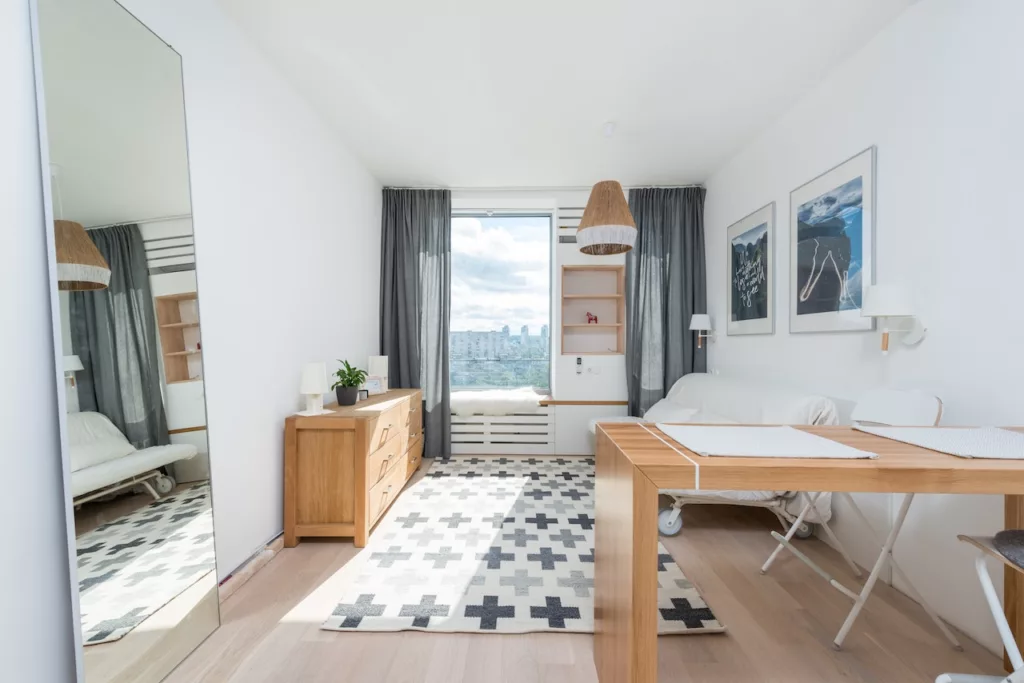
Estimated reading time: 5 minutes
Whether you’re a landlord or a tenant, choosing between furnished and unfurnished rentals can be challenging, as each living situation offers unique advantages and drawbacks. Unfurnished rentals might be better for those who want to add their own style or will be bringing a lot of personal belongings into the space.
On the other hand, landlords may see increased earning potential by offering furnished rentals and can attract more types of renters. To better understand the key differences between furnished and unfurnished rentals, here are some valuable insights to consider before deciding.
Table of contents

Furnished Rentals: What Do They Include?
A furnished rental typically comes with all the necessary furniture and appliances needed for comfortable living, including:
- Beds and mattresses
- Sofas and chairs
- Dining table and chairs
- Closets or wardrobes
- Kitchen appliances like a refrigerator, stove, microwave, or even a slow juicer.
However, renters must understand that what’s included in a furnished rental can vary depending on the landlord. Therefore, they must read their lease agreement carefully and ask any necessary questions before signing.
Pros of Furnished Rentals
- Typically easier to rent out: A fully furnished rental often appeals to prospective tenants looking for a convenient move-in ready home. Furnished rentals can make it easier for landlords to find renters quickly, reducing vacancy periods.
- Higher rent potential: Landlords may charge higher rents for furnished properties due to the added value they provide. Many tenants are willing to pay a premium for the convenience of not purchasing or moving their own furniture.
- Flexibility for short-term rentals: Furnished rentals are particularly popular among those seeking temporary accommodations, such as students, corporate employees on assignment, or individuals relocating temporarily. This flexibility allows landlords access to a broader pool of potential renters while catering specifically to these niche markets.
Cons of Furnished Rentals
- Maintenance costs: Furnishing a rental property requires an initial investment by the landlord in purchasing furniture and appliances that need regular maintenance or replacement over time. Landlords must factor these additional expenses into overall profitability calculations when considering whether furnishing is worth it financially.
- Potential damage liability: Including furnishings increases the risk of damages that could occur during a renter’s tenancy. Therefore, landlords may need to charge higher security deposits or invest in insurance policies to cover potential damages.
- Turnover challenges: Because furnished rentals often attract short-term tenants, this can lead to more frequent turnover and increased wear and tear on the property. Landlords must prepare for the additional work involved in managing these types of rentals, such as advertising vacancies, screening new tenants, and coordinating moving timelines more frequently.
- Less space: Because furnished rentals come with the necessities, tenants may have less room for personal belongings. They may need to invest in a storage unit or get rid of some items to make this living arrangement work.
What Are Semi-Furnished Rentals?
Semi-furnished property rentals refer to properties with some basic furniture and appliances. These properties typically include a bed, sofa, dining table, and refrigerator. However, they may have only some of the necessities of a fully furnished rental property — tenants may need to purchase additional furniture or appliances to complete their living arrangements.
Semi-furnished rentals are an attractive option for those renting out their first property or wanting more flexibility in their living space. This living arrangement offers tenants and landlords the convenience of some basic furnishings without the commitment or expense of a fully furnished rental.
What to Know About Unfurnished Rentals

On the other hand, an unfurnished rental usually only includes basic fixtures like light fittings and window coverings but leaves tenants responsible for providing their own furniture and appliances. Sometimes, an unfurnished apartment might have major kitchen appliances like a refrigerator or oven but will lack smaller essentials like beds or sofas.
Pros & Cons of Unfurnished Rentals
Generally, unfurnished rentals have a lower monthly rent than furnished properties. Tenants can choose their own furniture and decorations according to their tastes and preferences with an unfurnished rental, allowing them to create a personalized living space that feels like home.
Additionally, tenants are not responsible for any damages or wear-and-tear on the landlord’s furnishings because there aren’t any provided. However, tenants must purchase all necessary furniture, which can be expensive upfront, especially if starting from scratch without any existing pieces.
What Does it Mean When a Tenant Is Unfurnished?
An “unfurnished” tenant is someone who rents an empty property without any included furnishings from their landlord. They are responsible for providing their own furniture pieces and necessary household appliances during their tenancy period.
Unfurnished vs. Furnished Rental: Choose the Best Option For Your Needs
Choosing between furnished and unfurnished rentals depends on individual preferences and circumstances. Unfurnished rentals offer more flexibility in personalizing one’s living space but come with additional costs for purchasing furniture.
On the other hand, furnished rentals save renters from these expenses but might have higher monthly rent rates, benefitting landlords. When deciding, consider factors like budget constraints, moving timelines, and personal taste.